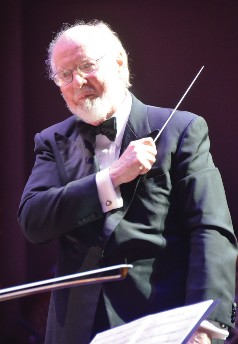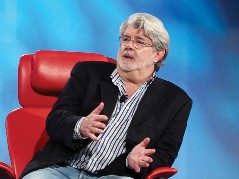3.2: John Williams - Star Wars
- Page ID
- 90685
We will start with an example that is familiar to most listeners: the music created for the Star Wars films. We will examine this music on its own terms, but through it we will also encounter five other works and styles that strongly impacted the creation of this score. No art exists in a vacuum. New works are built upon old, and creators rely upon cultural memory to communicate meaning. Even the Star Wars films were not conjured out of a vacuum—director George Lucas based his creation on Akira Kurosawa’s 1958 samurai film The Hidden Fortress.
You probably already have a wealth of associations with the Star Wars soundtrack—both personal and general—as a result of having watched these films. On the personal level, you might find that this music evokes nostalgic memories of watching Star Wars with your family as a child, or it might make you uncomfortable if you found the films particularly scary or sad. Such responses are valid and worth exploring. Here, however, we will focus on objective characteristics of the music that help us to explain how it enhances the story.
Williams’s Career
The soundtrack to the Star Wars films was composed by one of the most prolific and influential of all cinema composers, John Williams (b. 1932). Williams’s career took off in 1974, when director Steven Spielberg recruited him to score his first feature production, The Sugarland Express. The two went on to produce a string of hit films with memorable soundtracks, including Jaws, Close Encounters of the Third Kind, E.T., Schindler’s List, Saving Private Ryan, the Indiana Jones films, and the first two Jurassic Park films. This kind of collaboration has long played a role in the production of great music, and we will see similar partnerships at work in opera and ballet. It was Spielberg who recommended Williams to George Lucas, the director of the Star Wars films. His scores for the original Star Wars trilogy—A New Hope (1977), The Empire Strikes Back (1980), and Return of the Jedi (1983)—are among the best-known musical works created for the big screen.


Williams—who had studied music at UCLA and the Juilliard School— certainly knew his music history and concert repertoire. He also had decades of experience as a session musician in Los Angeles, recording soundtracks for television and film. He came to the task of writing film scores, therefore, with a deep understanding of how music can shape the viewer’s experience of a drama.
The Star Wars Soundtrack
At the heart of Williams’s soundtrack is a series of themes—about eleven per film—that represent individual characters, settings, or ideas. The viewer doesn’t need a guide to these themes. Instead, one quickly connects music with onscreen action as themes return throughout the films. Here, we will examine themes associated with Darth Vader, Luke Skywalker, Princess Leia, Yoda, and the Force. Williams carefully crafted each of these themes to represent the character or idea, and they are used both to amplify the onscreen action and to enrich the storytelling.
|
Time |
Form |
What to listen for |
|---|---|---|
|
0’00” |
intro |
The opening fanfare features the brass section |
|
0’06” |
A |
This triumphant trumpet melody contains multiple upward leaps |
|
0’17” |
The A theme is repeated with changes in the accompaniment |
|
|
0’26” |
B |
This melody features the strings |
|
0’48” |
A’ |
When the A material returns, the melody is played by violins and horns, giving it a different character |
|
1’10” |
End of listening guide |
We will begin with Luke Skywalker’s theme (officially titled “Main Theme”), which is first heard over the opening title. This is clearly the music of a hero. The opening fanfare suggests royalty, while the duple meter and moderate tempo tells us that this is a march. This, in combination with brass-heavy instrumentation, suggests a military character—a good representation of the Rebel Alliance. The melody soars into the upper range, confirming Skywalker’s confidence and authority with a series of leaps up to the high tonic scale degree. (This is the first and most important note of the scale on which the melody is built.) Trumpets, with their bright timbre, are more prominent than the other brass instruments. And, of course, Skywalker’s music is in the major mode. In addition, this theme has more emotional depth than Darth Vader’s. It is in a three-part form, which might be described as a b a’. While the a section has the characteristics described above, the b section features the string section, thereby introducing a warmer timbre and indicating that our hero has a human side. Finally, the fact that we hear Skywalker’s theme over the opening title tells us from the start who is going to emerge from this conflict victorious.
|
Time |
Form |
What to listen for |
|---|---|---|
|
0’00” |
intro |
The strings and percussion lay down a pattern of dotted rhythms suggesting a slow, militaristic march |
|
0’09” |
A |
The trombones and trumpets play a low, ominous melody |
|
0’18” |
B |
This section of the melody begins with a leap to the high range followed by a twisted chromatic descent |
|
0’28” |
B’ |
The repetition of B’ concludes differently |
|
0’38” |
End of listening guide |
The theme that represents the villain, Darth Vader, has many of the same characteristics. It, too, is a march (the theme is entitled “Imperial March”), and it features similar instrumentation. However, this theme is in the minor mode, which lets us know that this is the bad guy. The fact that the melody is played in a low range makes the music ominous, while the chromatic pitches and unusual harmonies make it mysterious. Darth Vader’s theme is forceful and threatening, perhaps even unstoppable, but it is not heroic.
The other themes are similarly suited to their subjects. Leia’s theme opens with a winding chromatic melody in the flute and oboe before unfolding into an expressive melody for french horn with muted strings in the background. The music suggests seduction and romance, while largely ignoring her role as an action hero (although there is a historical connection between the horn and heroes of the opera stage). Yoda’s theme is heard in the cellos and oboes with a peaceful accompaniment of strings, bassoons, and harp. The instrumentation resonates with his life in the woods, while the simplicity of the melody communicates his character. Both themes are heard at the same moderate tempo—an indication of romance in one case and peace in the other. Perhaps the slowest theme is that used to represent the Force, but now the tempo signifies inevitability and power. The theme itself is in the minor mode, not because it is tragic but because it is serious. It starts with a lone french horn, supported by tremolo in the strings, but grows dramatically in volume to embrace the whole orchestra.
|
“Princess Leia’s Theme” from Star Wars. Composer: John Williams. Performance: The Utah Symphony Orchestra, conducted by Varujan Kojian (1983) |
|
“Yoda’s Theme” from Star Wars. Composer: John Williams. Performance: London Symphony Orchestra, conducted by John Williams (1980) |
|
“The Force Theme” from Star Wars. Composer: John Williams. Performance: London Symphony Orchestra, conducted by John Williams (1980) |
This has been a fairly technical description of each theme’s attributes, but the character of the music is easy to perceive without specialized knowledge. It is worth a reminder, however, that our understanding of what music expresses is determined by our own cultural contexts. This music builds on centuries of stylistic development and depends on each listener’s lifetime of experience. We understand what it is trying to communicate because we dwell in the same musical world as the composer. Sound, however, seldom has objective meaning. We recognize the sounds of a military march because we have heard one somewhere else. We know that swelling strings signify romance because we have seen a hundred other movies, which in turn build on older theatrical traditions. A listener from a culture that had no military bands and in which, say, organ music was understood to signal romance would not make these connections.


